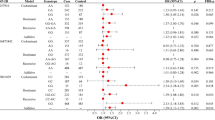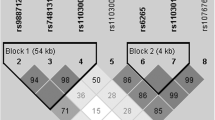Abstract
Purpose
LDH caused by lumbar disc degeneration is associated with genetic factors. However, the role of ADAMTS6 and ADAMTS17 genes in LDH risk is still unknown.
Methods
To investigate the interaction between ADAMTS6 and ADAMTS17 variants in the susceptibility of LDH, five SNPs were genotyped in 509 patients and 510 healthy individuals. The experiment used logistic regression to calculate odds ratio (OR) and 95% confidence interval (CI). Multi-factor dimensionality reduction (MDR) was chosen to evaluate impact of interaction of SNP-SNP on susceptibility to LDH.
Results
ADAMTS17-rs4533267 is significantly associated with reducing risk of LDH (OR = 0.72, 95% CI = 0.57–0.90, p = 0.005). Stratified analysis indicates that ADAMTS17-rs4533267 is significantly associated with the reducing risk of LDH among participants aged ≤ 48 years old. In addition, we observed that ADAMTS6-rs2307121 was associated with increasing risk of LDH in females. MDR analysis shows that single-locus model composed by ADAMTS17-rs4533267 can be chosen as the best model for predicting susceptibility to LDH (CVC = 10/10, test accuracy = 0.543).
Conclusion
ADAMTS6-rs2307121 and ADAMTS17-rs4533267 are potentially associated with LDH susceptibility. In particular, ADAMTS17-rs4533267 has a strong association with reducing risk of LDH.

Similar content being viewed by others
Data availability
The datasets used or analysed during the current study are available from the corresponding author on reasonable request.
Abbreviations
- LDH:
-
Lumbar disc herniation
- CI:
-
Confidence interval
- LBP:
-
Low back pain
- ADAMTS:
-
A disintegrin and metalloproteinase with thrombospondin motifs
- MRI:
-
Magnetic resonance imaging
- HWE:
-
Hardy–Weinberg equilibrium
- LDD:
-
Lumber intervertebral disc degeneration
References
Campa D, Barrdahl M, Gaudet MM, Black A, Chanock SJ, Diver WR et al (2015) Genetic risk variants associated with in situ breast cancer. Breast Cancer Res BCR 17:82
Dagenais S, Caro J, Haldeman S (2008) A systematic review of low back pain cost of illness studies in the United States and internationally. The spine J 8(1):8–20
Perera RS, Dissanayake PH, Senarath U, Wijayaratne LS, Karunanayake AL, Dissanayake VHW (2017) Variants of ACAN are associated with severity of lumbar disc herniation in patients with chronic low back pain. PLoS ONE 12(7):e0181580
Zhang C, Liu S, Wu J (2015) Association of the polymorphism of trail with the risk and severity of lumbar disc degeneration in Chinese Han population. Genet Test Mol Biomarkers 19(8):450–453
Xu X, Li X, Wu W (2015) Association between overweight or obesity and lumbar disk diseases: a meta-analysis. J Spinal Disord Tech 28(10):370
Solovieva S, Noponen N, Mannikko M, Leino-Arjas P, Luoma K, Raininko R et al (2007) Association between the aggrecan gene variable number of tandem repeats polymorphism and intervertebral disc degeneration. Spine 32(16):1700–1705
Solovieva S, Kouhia S, Leino-Arjas P, Ala-Kokko L, Luoma K, Raininko R et al (2004) Interleukin 1 polymorphisms and intervertebral disc degeneration. Epidemiology 15(5):626–633
Basaran R, Senol M, Ozkanli S, Efendioglu M, Kaner T (2017) Correlation of matrix metalloproteinase (MMP)-1, -2, -3, and -9 expressions with demographic and radiological features in primary lumbar intervertebral disc disease. J Clin neurosci 41:46–49
Mio F, Chiba K, Hirose Y, Kawaguchi Y, Mikami Y, Oya T et al (2007) A functional polymorphism in COL11A1, which encodes the alpha 1 chain of type XI collagen, is associated with susceptibility to lumbar disc herniation. Am J Hum Genet 81(6):1271–1277
Jones GC, Riley GP (2005) ADAMTS proteinases: a multi-domain, multi-functional family with roles in extracellular matrix turnover and arthritis. Arthritis Res Ther 7(4):160–169
Apte SS (2009) A disintegrin-like and metalloprotease (reprolysin-type) with thrombospondin type 1 motif (ADAMTS) superfamily: functions and mechanisms. J Biol Chem 284(46):31493–31497
Apte SS (2004) A disintegrin-like and metalloprotease (reprolysin type) with thrombospondin type 1 motifs: the ADAMTS family. Int J Biochem Cell Biol 36(6):981–985
Kelwick R, Desanlis I, Wheeler GN, Edwards DR (2015) The ADAMTS (a disintegrin and metalloproteinase with thrombospondin motifs) family. Genome Biol 16:113
Poonpet T, Honsawek S, Tammachote N, Kanitnate S, Tammachote R (2013) ADAMTS14 gene polymorphism associated with knee osteoarthritis in Thai women. Genet Mol Res GMR 12(4):5301–5309
Kumar S, Rao N, Ge R (2012) Emerging roles of ADAMTSs in angiogenesis and cancer. Cancers 4(4):1252–1299
El Khoury L, Posthumus M, Collins M, Handley CJ, Cook J, Raleigh SM (2013) Polymorphic variation within the ADAMTS2, ADAMTS14, ADAMTS5, ADAM12 and TIMP2 genes and the risk of Achilles tendon pathology: a genetic association study. J Sci Med Sport 16(6):493–498
Cal S, López-Otín C (2015) ADAMTS proteases and cancer. Matrix Biol 44–46:77–85
Xie Y, Gou Q, Xie K, Wang Z, Wang Y, Zheng H (2016) ADAMTS6 suppresses tumor progression via the ERK signaling pathway and serves as a prognostic marker in human breast cancer. Oncotarget 7(38):61273–61283
Morales J, Al-Sharif L, Khalil DS, Shinwari JM, Bavi P, Al-Mahrouqi RA et al (2009) Homozygous mutations in ADAMTS10 and ADAMTS17 cause lenticular myopia, ectopia lentis, glaucoma, spherophakia, and short stature. Am J Hum Genet 85(5):558–568
Yu Y, Xie Z, Wang J, Chen C, Du S, Chen P et al (2016) Single-nucleotide polymorphisms of MMP2 in MMP/TIMP pathways associated with the risk of alcohol-induced osteonecrosis of the femoral head in Chinese males: a case-control study. Medicine 95(49):e5407
Du J, Jin T, Cao Y, Chen J, Guo Y, Sun M et al (2016) Association between genetic polymorphisms of MMP8 and the risk of steroid-induced osteonecrosis of the femoral head in the population of northern China. Medicine 95(37):e4794
Le MC, Pockert A, Buttle DJ, Freemont AJ, Hoyland JA (2007) Matrix synthesis and degradation in human intervertebral disc degeneration. Biochem Soc Trans 35(4):652–655
Bachmeier BE, Nerlich A, Mittermaier N, Weiler C, Lumenta C, Wuertz K et al (2009) Matrix metalloproteinase expression levels suggest distinct enzyme roles during lumbar disc herniation and degeneration. Eur Spine J 18(11):1573–1586
Kalb S, Martirosyan NL, Kalani MYS, Broc GG, Theodore N (2012) Genetics of the degenerated intervertebral disc. World Neurosurg 77(3–4):491–501
Liu S, Wu N, Liu J, Liu H, Su X, Liu Z et al (2016) Association between ADAMTS-4 gene polymorphism and lumbar disc degeneration in Chinese Han population. J Orthop Res Off Publ Orthop Res Soc 34(5):860–864
Wu N, Chen J, Liu H, Zhao L, Liu S, Liu J et al (2014) The involvement of ADAMTS-5 genetic polymorphisms in predisposition and diffusion tensor imaging alterations of lumbar disc degeneration. J Orthop Res Off Publ Orthop Res Soc 32(5):686–694
Zhang X, Zhao G, Zhang Y, Wang J, Wang Y, Cheng L et al (2018) Activation of JNK signaling in osteoblasts is inversely correlated with collagen synthesis in age-related osteoporosis. Biochem Biophys Res Commun 504(4):771–776
Min SK, Nakazato K, Ishigami H, Hiranuma K (2014) Cartilage intermediate layer protein and asporin polymorphisms are independent risk factors of lumbar disc degeneration in male collegiate athletes. Cartilage 5(1):37–42
Miller JA, Schmatz C, Schultz AB (1988) Lumbar disc degeneration: correlation with age, sex, and spine level in 600 autopsy specimens. Spine 13(2):173–178
Acknowledgements
We are very grateful to the participants who provided blood samples for this experiment and the professionals responsible for blood collection, as well as to the reviewers and editors for their patience.
Funding
No funding was received for this research.
Author information
Authors and Affiliations
Contributions
HPB wrote the paper; JF analysed and interpreted the data; ZL conceived and designed the experiments; HPB and JF performed the experiments. All authors reviewed the manuscript.
Corresponding author
Ethics declarations
Conflicts of Interest
HPB, JF, ZL have declared that they have no conflict of interest.
Consent for publication
HPB, JF, ZL have declared that they agree to publish.
Ethical approval
This study was performed in accordance with the World Medical Association Declaration of Helsinki and was approved by the ethics committee of the Second Affiliated Hospital of Xi'an Medical College. Written informed consent was obtained from all of the subjects before participating.
Additional information
Publisher's Note
Springer Nature remains neutral with regard to jurisdictional claims in published maps and institutional affiliations.
Supplementary Information
Below is the link to the electronic supplementary material.
Rights and permissions
Springer Nature or its licensor (e.g. a society or other partner) holds exclusive rights to this article under a publishing agreement with the author(s) or other rightsholder(s); author self-archiving of the accepted manuscript version of this article is solely governed by the terms of such publishing agreement and applicable law.
About this article
Cite this article
Han, P., Jiang, F. & Zhang, L. The role of ADAMTS6 and ADAMTS17 polymorphisms in susceptibility to lumbar disc herniation in Chinese Han population. Eur Spine J 32, 1106–1114 (2023). https://doi.org/10.1007/s00586-023-07586-8
Received:
Revised:
Accepted:
Published:
Issue Date:
DOI: https://doi.org/10.1007/s00586-023-07586-8




